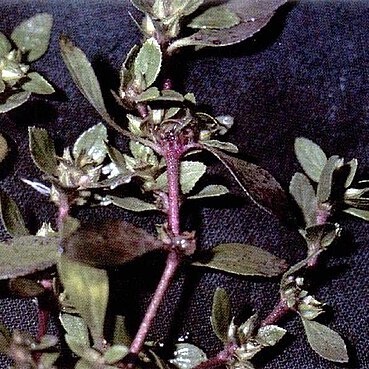Erect to prostrate herbs, annual or perennial. Indumentum of multiseriate glandular or uniseriate eglandular hairs. Leaves opposite, usually serrulate, with teeth often conspicuously red gland-tipped, base attenuated into a short petiole. Stipules narrow-triangular, herbaceous with scarious, laciniate margin, usually with conspicuous midrib, apex acuminate, base often connate and/or adnate to petiole, persistent. Flowers solitary, paired or in dense fascicles, bracteoles present. Sepals 3–5, conspicuous, usually herbaceous with scarious margin, ± fimbriate, concave, sometimes keeled, persistent. Petals as many as sepals, white to pink, persistent. Stamens 3–10, pink to purple, persistent. Capsule often obscured by persistent floral parts, walls subcrustaceous. Seeds cylindrical, straight or curved, smooth, faintly marked or alveolate.
Herbs [subshrubs], terrestrial [aquatic], glandular-pubescent. Stems ascending to prostrate, solid or pithy, not rooting at nodes [rooting at proximal nodes]. Leaves: stipules nearly membranous; petiole present; blade margins serrulate. Inflorescences usually cymes, rarely flowers solitary. Pedicels present. Flowers: sepals 5, distinct, equal, carinate, apex acuminate or acute; petals 5, apex acute; stamens (5 or 7–)10; pistil 5-carpellate; ovary 5-locular, apex ± acute; styles 5; stigmas 5. Capsules cartilaginous. Seeds 3–6[–10] per locule, brown, slightly curved, surface obscurely reticulate with rectangular pits. x = 6.
Herbs annual, perennial, or subshrubs, erect or prostrate, richly branched. Leaves opposite, petiolate; leaf blade margin serrulate. Flowers numerous, arranged in axillary cymes or clustered in leaf-axils, rarely solitary, very small. Sepals 5, free, leathery, with conspicuous midrib, margin membranous, apex long acuminate. Petals 5, free, membranous. Stamens 5-10. Ovary ovoid-globose or subglobose, 5-loculed, many-ovuled, apex subacute; styles short; stigmas capitate. Capsule sub-bony, 5-septicidal. Seeds oblong, slightly curved, reticulate with elliptic pits.
Annual herbs, erect, ascending or decumbent. Leaves opposite, shortly petioled, finely serrate. Stipules persistent. Flowers (in the Malaysian species) fascicled or glomerate, 5-merous. Sepals free, acutely acuminate, keeled by the strongish midrib, with broad pellucid nerveless margins. Petals oval-oblong, thinly membranous. Stamens the same number as petals or more, but not more than 10. Ovary and capsule globose or ovoid, 5-celled; stigmas capitate. Seeds oblong, with rounded ends, faintly curved, with a faint or strong, scalariform reticulation.
Fls 5-merous; sep distinct; stamens 5 or 10; ovary 5-locular, the placentas typically extending to its summit; fr globose or ovoid; seeds numerous, minute, cylindric or clavate, obscurely areolate; small marsh-herbs with axillary fls and firm-walled frs. 20+, widespread.
Stamens 5–12 (usually 5 or 10), those opposite the petals shorter or absent, those alternating with the petals often with filaments broadened at the base; anther-thecae dehiscing by slits.
Seeds subcylindric with rounded ends or 3-angled, often shining, brown or almost black and with the cells of the testa often longitudinally tessellated; embryo straight or curved.
Leaves opposite, usually sessile or subsessile, obovate, oblanceolate, lanceolate, elliptic or linear, entire or serrate; stipules usually denticulate or puberulous at the margin.
Fruit a septicidal capsule with the valves separating from the central column from above and so releasing the numerous seeds.
Flowers axillary, sessile or pedicelled, solitary or fascicled or in small cymes, sometimes crowded and verticillate.
Ovary 5 (rarely 4)-locular, with many axile ovules in each loculus; carpels almost free; styles free, one per carpel.
Petals 4–5 (6), free, as long as or slightly shorter than the sepals, oblong, oblanceolate, or linear-oblong.
Prostrate or erect annual or perennial herbs or undershrubs, often pubescent, sometimes glandular-pubescent.
Sepals 4–5 (6), free, lanceolate, elliptic or oblong, usually keeled and with hyaline margins, imbricate.

